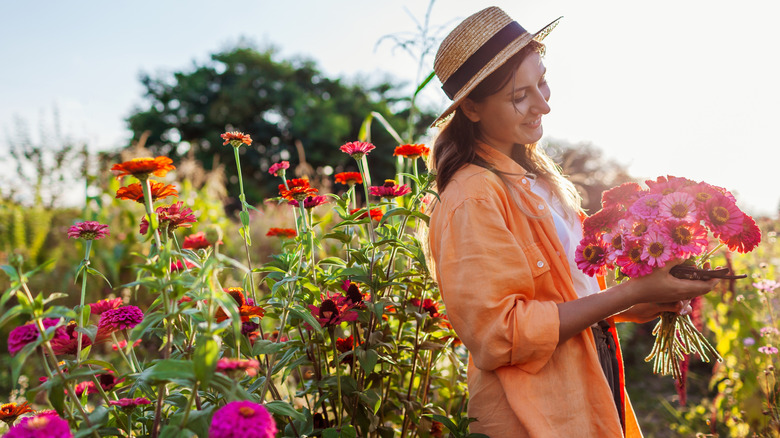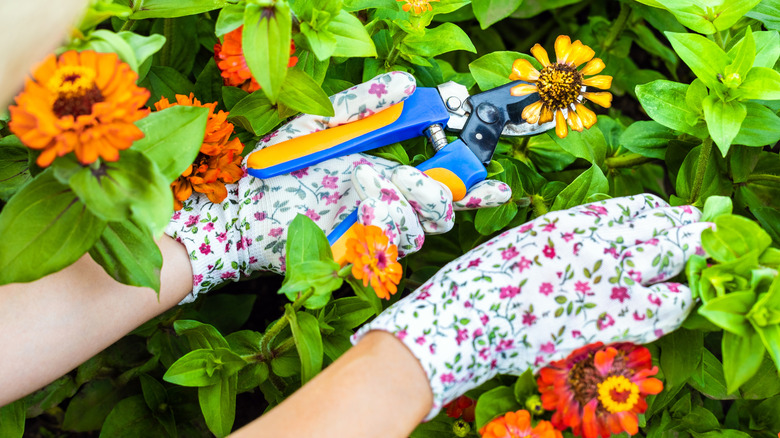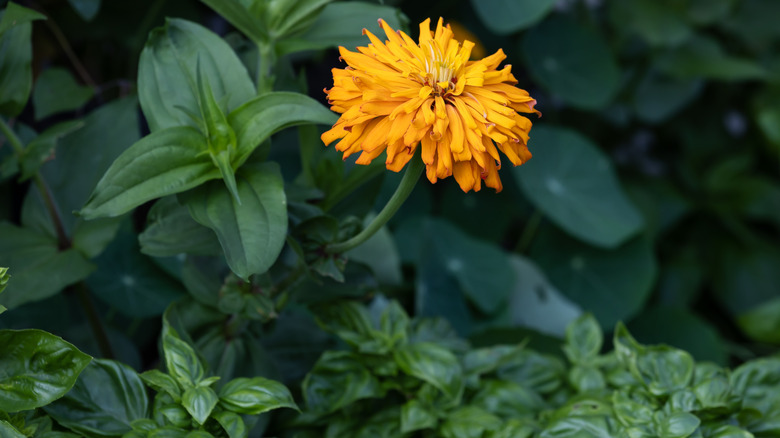One Of The Best Zinnia Companion Plants Is A Delicious, Easy-To-Grow Herb
Zinnias are an easy plant to grow and care for, making them a perfect beginner plant. As annuals, they can grow in any region in just about any soil that has good drainage. Zinnias (Zinnia elegans) also tolerate heat and direct sunlight well; they are fun, brightly colored plants that add vibrance and joy to your garden. When it comes to adding a companion plant to zinnias for some variety, look no further than the delicious and easy-to-grow basil (Ocimum basilicum). Also grown as an annual in most regions, basil's tender stem and love of full sun make it perfect to plant with your zinnias.
Zinnias are a wonderful companion plant, because their bright blooms can help to attract pollinators and distract some pests that would otherwise eat basil. Basil returns this favor as its strong fragrance confuses or deters pests on their way to the zinnias. Ultimately, zinnias, with their bright-hued flowers, and basil, with its balance of greenery, just look good together.
How to grow zinnias and basil plants
Fresh basil is both convenient in the kitchen and easy to grow, a lovely and low-maintenance companion plant. It can be grown both in- and outdoors depending on the time of year. One simple option is to start it from seeds six weeks before the last frost, and transfer the seedlings outdoors when temperatures are higher in a spot with full sun. Start your seeds in a pot with good drainage and keep the soil moist. After six or more leaves form, you can begin harvesting them. Harvesting regularly and removing flowers later in the season can help promote branching and leaf production. Sometimes, basil grows so well that you can find yourself with an accidental overload, but you can harvest and store the fresh herbs for later.
Zinnias require nearly identical care as basil. From moist, well-drained soil to plentiful sunlight, zinnias and basil will thrive together in the same setting. Start zinnia seeds indoors at the same time as basil, or direct sow them after the last frost. Neither annual will survive frost or cold winters. Neither plant requires much fertilizing for survival, though an occasional feed could increase production. Like basil, zinnias also benefit from pinching and pruning, especially early in their lifespan.
Other plants to complement your zinnias and basil
Companion plants truly can benefit a garden, and zinnias are able to thrive alongside many different plants. If you're looking to build upon your basil-zinnia pairing, both plants grow well with tomatoes and a variety of peppers. Similar to its relationship with zinnias, basil's aromatic leaves help repel certain pests for both peppers and tomatoes. Zinnias, basil, and tomatoes all thrive in similar environments and are all grown as annuals. Peppers vary; they can grow as perennials in warmer areas (USDA Hardiness Zones 9 through 13) and are treated as annuals in colder climates (zones 8 and under). Zinnias' brightly colored flowers can also help attract pollinators for both tomatoes and peppers to increase yields.
If you want to add some color and variety, dahlias, cosmos, and calendulas grow nicely alongside zinnias and basil. All three flowers are usually grown as annuals. Dahlias are higher maintenance than zinnias, but the two tend to grow well together. Cosmos are considered easy-going and, as long as you plant similarly-sized varieties, they'll grow beautifully with zinnias. Calendula can also attract insects to help pollinate the group.


